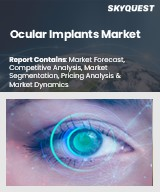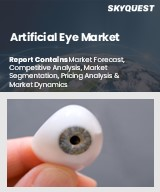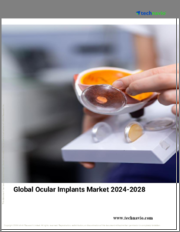
|
시장보고서
상품코드
1576656
안구 임플란트 시장 규모, 점유율, 예측, 동향 분석 : 유형별(강막, 스톡, 안와, 안구내, 망막, 각막), 재료별(실리콘, 하이드록시아파타이트), 용도별(인공 장기, 안구 성형술, 녹내장 수술), 최종사용자별 - 세계 예측(-2031년)Ocular Implants Market Size, Share, Forecast, & Trends Analysis by Type (Scleral, Stock, Orbital, Intraocular, Retinal, Corneal) Material (Silicon, Hydroxyapatite) Application (Prosthesis, Ocuplasty, Glaucoma Surgery) End User - Global Forecast to 2031 |
||||||
세계 안구 임플란트 시장은 2024년부터 2031년까지 6.1%의 CAGR로 2031년까지 234억 3,000만 달러에 달할 것으로 예상됩니다.
광범위한 2차 및 1차 연구와 시장 시나리오에 대한 심층 분석을 통해 본 보고서는 주요 산업 촉진요인, 억제요인, 도전 과제 및 기회 분석으로 구성되어 있습니다. 세계 안구 임플란트 시장의 성장은 노인 인구의 안과 질환 증가, 최소침습 수술의 채택 확대, 의료비 지출 증가, 안구 임플란트 첨단 기술의 성장, 안구 임플란트 사고 사례의 증가로 인해 안구 임플란트의 필요성이 증가하고 있는 것이 배경입니다. 그러나 수술 후 감염 및 염증 가능성, 숙련된 안과 전문의 부족, 엄격한 규제 및 승인 절차가 이 시장의 성장을 저해하는 요인으로 작용하고 있습니다.
또한, 안과용 나노기술에 기반한 약물전달 및 안구 조직 공학은 시장 성장의 기회를 창출할 것으로 예상됩니다. 그러나 안구 임플란트에 대한 인식 부족, 기술적 복잡성, 높은 임플란트 비용, 제품 리콜 증가는 안구 임플란트 세계 시장의 주요 도전 과제입니다.
목차
제1장 소개
제2장 조사 방법
제3장 주요 요약
제4장 시장 성장요인
- 개요
- 성장 촉진요인
- 노인 인구 증가와 안질환 유병률 높이
- 최소침습 수술 채용 증가
- 헬스케어 지출 증가
- 안구 임플란트의 기술적 진보
- 사고 사례 증가에 의한 안구 임플란트 요구 상승
- 성장 억제요인
- 수술후 감염증이나 염증 리스크
- 숙련된 안과 외과의의 부족
- 엄격한 규제와 승인 프로세스
- 기회
- 안과 나노기술에 기반한 약물전달
- 눈 조직공학
- 과제
- 지방의 인식 부족
- 기술적인 복잡성
- 임플란트의 고비용
- 제품 리콜 증가
- 동향
- 바이오소재 기반 안구 임플란트
- AI에 의한 3D 프린트 의안
- 약물 용출 임플란트
- 요인 분석
- 규제 분석
- 가격 분석
- 사례 연구
- Porter's Five Forces 분석
제5장 안구 임플란트 시장 평가 : 유형별
- 개요
- 비기능성 임플란트
- 안구 임플란트
- 강막 쉘
- 스톡 쉘
- 커스텀 메이드 보형물
- 안와 임플란트
- 안구 임플란트
- 기능적 임플란트
- 안내 렌즈
- 녹내장 임플란트
- 망막 임플란트
- 각막 임플란트
제6장 안구 임플란트 시장 평가 : 재료별
- 개요
- 불활성 재료
- 유리
- 실리콘
- 메틸 메타크릴레이트
- 바이오 통합 재료
- 하이드록시아파타이트
- 다공성 폴리에틸렌
- 산화알루미늄
제7장 안구 임플란트 시장 평가 : 용도별
- 개요
- 안구 임플란트
- 녹내장 수술
- 눈 성형술
- 약물전달
- 기타 용도
제8장 안구 임플란트 시장 평가 : 최종사용자별
- 개요
- 병원
- 안과 클리닉
- 외래 수술 센터(ASCs)
- 기타 최종사용자
제9장 안구 임플란트 시장 평가 : 지역별
- 개요
- 북미
- 미국
- 캐나다
- 유럽
- 독일
- 프랑스
- 영국
- 이탈리아
- 스페인
- 네덜란드
- 스위스
- 스웨덴
- 벨기에
- 기타 유럽(RoE)
- 아시아태평양
- 중국
- 일본
- 인도
- 호주
- 한국
- 기타 아시아태평양(RoAPAC)
- 라틴아메리카
- 브라질
- 멕시코
- 기타 라틴아메리카(RoLATAM)
- 중동 및 아프리카
제10장 경쟁 분석
- 개요
- 주요 성장 전략
- 경쟁 벤치마킹
- 경쟁 대시보드
- 업계 리더
- 시장 차별화 요인
- 선행 기업
- 신흥 기업
- 주요 기업의 시장 점유율 분석(2023년)
제11장 기업 개요(사업 개요, 재무 개요, 제품 포트폴리오, 전략적 전개)
- Alcon Inc.
- Bausch+Lomb Corporation
- Carl Zeiss AG
- Johnson & Johnson Vision Care, Inc.
- STAAR Surgical Company
- Morcher GmbH
- Hoya Corporation
- Glaukos Corporation
- ABBVIE INC.
- Vivani Medical Inc.
(참고 : 상위 5개사 SWOT 분석을 제공합니다)
제12장 부록
ksm 24.11.21Ocular Implants Market Size, Share, Forecast, & Trends Analysis by Type (Scleral, Stock, Orbital, Intraocular, Retinal, Corneal) Material (Silicon, Hydroxyapatite) Application (Prosthesis, Ocuplasty, Glaucoma Surgery) End User-Global Forecast to 2031
The global ocular implants market is projected to reach $23.43 billion by 2031 at a CAGR of 6.1% from 2024 to 2031.
Succeeding extensive secondary and primary research and in-depth analysis of the market scenario, the report comprises the analysis of key industry drivers, restraints, challenges, and opportunities. The growth of the global ocular implants market is driven by the increasing eye problems in the geriatric population, growing adoption of minimally invasive surgeries, rising healthcare expenditure, growing cutting-edge technologies in ocular implants, and an increase in the number of accident cases, raising the need for ocular implants. However, the possibility of post-surgery infection and inflammation, lack of trained ophthalmic surgeons, strict regulations, and approval processes are restraining the growth of this market.
Furthermore, ocular nanotechnology-based drug delivery and ocular tissue engineering are expected to generate market growth opportunities. However, lack of awareness regarding ocular implants in rural areas, technological complexities, high implant costs, and rising product recalls are major challenges in the global ocular implants market.
The report offers a competitive landscape based on an extensive assessment of the product portfolio offerings, geographic presences, and key strategic developments adopted by leading market players in the industry in the past three to four years. The key players operating in the ocular implants market are Alcon Inc. (Switzerland), Bausch + Lomb Corporation (Canada), Carl Zeiss AG (Germany), Johnson & Johnson Vision Care, Inc. (U.S), STAAR SURGICAL COMPANY (U.S), Morcher GmbH (Germany), HOYA CORPORATION (Japan), GLAUKOS CORPORATION (U.S), AbbVie Inc. (U.S.), and Vivani Medical Inc. (U.S).
Among all the types studied in this report, in 2024, the functional implant segment is expected to account for the larger share of 81.7% of the ocular implants market. The functional implant segment is further segmented into intraocular lens, glaucoma implant, retinal implant, and corneal implant. The large share of the segment is attributed to the increasing burden of glaucoma, rising demand for functional implants due to rising eye injuries, and cutting-edge technologies in functional implants. For instance, the Bionic eye is a new technology that improves light sensitivity and generates a sense of vision for vision loss individuals. This technology was developed by the Second Sight company, developed by Mark Humayun, Alfred E. Mann, and Second Sight.
Among all the materials studied in this report, the inert materials segment is expected to account for the largest share of the ocular implant market in 2024. This segment is further categorized into glass, silicone, and methylmethacrylate. The segment's large market share can be attributed to the advantages of inert materials, such as cost-effectiveness, biological compatibility, and no allergic reactions.
Among all the applications studied in this report, in 2024, the glaucoma surgery segment is expected to account for the largest share of 32.6% of the ocular implants market. The large share of the segment is attributed to the increasing burden of glaucoma and the growing demand for functional implants in severe glaucoma cases. Additionally, individuals with diabetes, foresightedness, or eye injury have probably experienced glaucoma. According to the Centers for Disease Control And Prevention, in the U.S., in May 2024, around 38.4 million individuals were living with diabetes, which is 11.6% of the U.S. population.
Among all the end users studied in this report, in 2024, the hospitals segment is expected to account for the largest share of the ocular implants market. The segment's large share is attributed to the increasing number of hospitals specializing in ophthalmology, the availability and accessibility of advanced facilities in hospitals, advanced surgical instruments, and skilled surgical staff. Hospitals are the first preferred health system for accessing medical facilities and treatment, especially for surgical procedures.
An in-depth analysis of the geographical scenario of the global ocular implants market provides detailed qualitative and quantitative insights into the five major geographies (North America, Europe, Asia-Pacific, Latin America, and the Middle East & Africa) along with the coverage of major countries in each region. In 2024, North America is expected to account for the largest share of 41.8% of the ocular implants market. The large share of this regional market is attributed to the well-established healthcare infrastructure, high prevalence of eye disorders, presence of key market players, patients' preference for ophthalmic surgeries, and commercial availability of advanced ocular implant products.
Scope of the Report:
Ocular implants Market Assessment-by Type
- Non Functional Implants
- Ocular Implants
- Scleral shells
- Stock Shells
- Custom-made Prosthesis
- Orbital Implants
- Functional Implants
- Intraocular Lens
- Glaucoma Implants
- Retinal Implants
- Corneal Implants
Ocular Implants Market Assessment-by Material
- Inert Materials
- Glass
- Silicone
- Methyl methacrylate
- Biointegrated Materials
- Hydroxyapatite
- Porous Polyethylene
- Aluminum Oxide
Ocular Implants Market Assessment-by Application
- Ocular Prosthesis
- Glaucoma Surgery
- Ocuplasty
- Drug Delivery
- Other Applications
Note: Other applications include vision correction, cosmetic surgery, and age-related macular degeneration.
Ocular Implants Market Assessment-by End User
- Hospitals
- Ophthalmic Clinics
- Ambulatory Surgery Centers (ASCs)
- Other End Users
Note: Other end users include academic & research institutes and pharmaceutical & biotechnology companies.
Ocular Implants Market Assessment-by Geography
- North America
- U.S.
- Canada
- Europe
- Germany
- France
- U.K
- Italy
- Spain
- Switzerland
- Netherlands
- Sweden
- Belgium
- Rest of Europe (RoE)
- Asia-Pacific (APAC)
- China
- Japan
- India
- South Korea
- Australia
- Rest of Asia-Pacific (RoAPAC)
- Latin America
- Brazil
- Mexico
- Rest of Latin America
- Middle East & Africa
TABLE OF CONTENTS
1. Introduction
- 1.1. Market Definition & Scope
- 1.2. Market Ecosystem
- 1.3. Currency & Limitations
- 1.4. Key Stakeholders
2. Research Methodology
- 2.1. Research Approach
- 2.2. Data Collection & Validation Process
- 2.2.1. Secondary Research
- 2.2.2. Primary Research/Interviews with Key Opinion Leaders from the Industry
- 2.3. Market Sizing & Forecasting
- 2.3.1. Market Size Estimation Approach
- 2.3.2. Growth Forecast Approach
- 2.3.3. Market Share Analysis
- 2.4. Assumptions for the Study
3. Executive Summary
4. Factors Affecting Market Growth
- 4.1. Overview
- 4.2. Drivers
- 4.2.1. Rising Geriatric Population Coupled with High Prevalence of Eye Diseases
- 4.2.2. Rise in Adoption of Minimally Invasive Surgeries
- 4.2.3. Increasing Healthcare Expenditure
- 4.2.4. Technological Advancements in Ocular Implants
- 4.2.5. Increasing Accident Cases Raising the Need for Ocular Implants
- 4.3. Restraints
- 4.3.1. Risk of Post-surgery Infections and Inflammations
- 4.3.2. Lack of Skilled Ophthalmic Surgeons
- 4.3.3. Strict Regulations and Approval Process
- 4.4. Opportunities
- 4.4.1. Ocular Nanotechnology-based Drug Delivery
- 4.4.2. Ocular Tissue Engineering
- 4.5. Challenges
- 4.5.1. Lack of Awareness in Rural Areas
- 4.5.2. Technological Complexities
- 4.5.3. High Cost of Implants
- 4.5.4. Increasing Number of Product Recalls
- 4.6. Trends
- 4.6.1. Biomaterial-based Ocular Implants
- 4.6.2. AI-driven 3D Printed Prosthetic Eyes
- 4.6.3. Drug-eluting Implants
- 4.7. Factor Analysis
- 4.8. Regulatory Analysis
- 4.9. Pricing Analysis
- 4.10. Case Studies
- 4.11. Porter's Five Forces Analysis
5. Ocular Implants Market Assessment, by Type
- 5.1. Overview
- 5.2. Non Functional Implants
- 5.2.1. Ocular Implant
- 5.2.1.1. Scleral Shells
- 5.2.1.2. Stock Shells
- 5.2.1.3. Custom Made Prosthesis
- 5.2.2. Orbital Implants
- 5.2.1. Ocular Implant
- 5.3. Functional Implants
- 5.3.1. Intraocular Lens
- 5.3.2. Glaucoma Implants
- 5.3.3. Retinal Implants
- 5.3.4. Corneal Implants
6. Ocular Implants Market Assessment, by Material
- 6.1. Overview
- 6.2. Inert materials
- 6.2.1. Glass
- 6.2.2. Silicone
- 6.2.3. Methylmethacrylate
- 6.3. Biointegrated Materials
- 6.3.1. Hydroxyapatite
- 6.3.2. Porous Polyethylene
- 6.3.3. Aluminum Oxide
7. Ocular Implants Market Assessment, by Application
- 7.1. Overview
- 7.2. Ocular Prosthesis
- 7.3. Glaucoma Surgery
- 7.4. Oculoplasty
- 7.5. Drug Delivery
- 7.6. Other Applications
8. Ocular Implants Market Assessment, by End User
- 8.1. Overview
- 8.2. Hospitals
- 8.3. Ophthalmic Clinics
- 8.4. Ambulatory Surgery Centers (ASCs)
- 8.5. Other End Users
9. Ocular Implants Market Assessment, by Geography
- 9.1. Overview
- 9.2. North America
- 9.2.1. U.S.
- 9.2.2. Canada
- 9.3. Europe
- 9.3.1. Germany
- 9.3.2. France
- 9.3.3. U.K.
- 9.3.4. Italy
- 9.3.5. Spain
- 9.3.6. Netherlands
- 9.3.7. Switzerland
- 9.3.8. Sweden
- 9.3.9. Belgium
- 9.3.10. Rest of Europe (RoE)
- 9.4. Asia-Pacific
- 9.4.1. China
- 9.4.2. Japan
- 9.4.3. India
- 9.4.4. Australia
- 9.4.5. South Korea
- 9.4.6. Rest of Asia-Pacific (RoAPAC)
- 9.5. Latin America
- 9.5.1. Brazil
- 9.5.2. Mexico
- 9.5.3. Rest of Latin America (RoLATAM)
- 9.6. Middle East & Africa
10. Competition Analysis
- 10.1. Overview
- 10.2. Key Growth Strategies
- 10.3. Competitive Benchmarking
- 10.4. Competitive Dashboard
- 10.4.1. Industry Leaders
- 10.4.2. Market Differentiators
- 10.4.3. Vanguards
- 10.4.4. Emerging Companies
- 10.5. Market Share Analysis of Key Players (2023)
11. Company Profiles (Business Overview, Financial Overview, Product Portfolio, and Strategic Developments)
- 11.1. Alcon Inc.
- 11.2. Bausch + Lomb Corporation
- 11.3. Carl Zeiss AG
- 11.4. Johnson & Johnson Vision Care, Inc.
- 11.5. STAAR Surgical Company
- 11.6. Morcher GmbH
- 11.7. Hoya Corporation
- 11.8. Glaukos Corporation
- 11.9. ABBVIE INC.
- 11.10. Vivani Medical Inc.
(Note: SWOT analyses of the top 5 companies will be provided.
12. Appendix
- 12.1. Available Customization
- 12.2. Related Reports



















